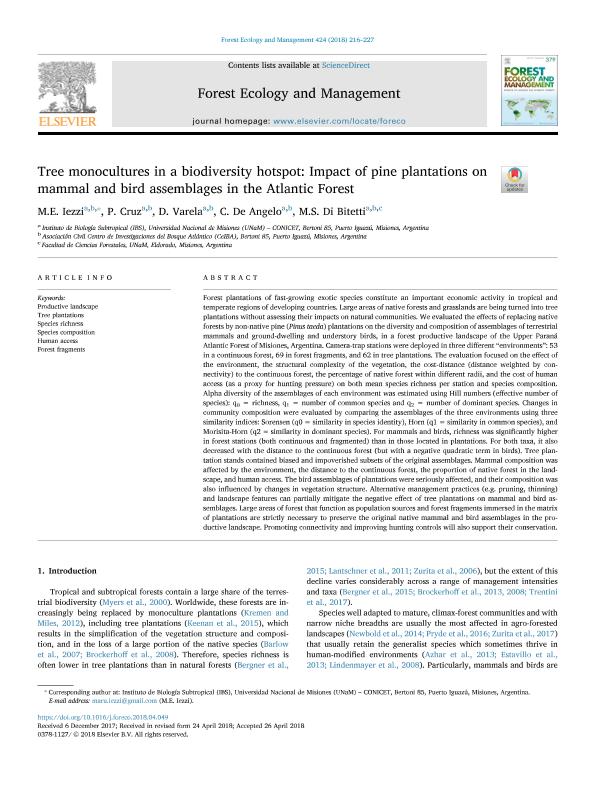Mostrar el registro sencillo del ítem
dc.contributor.author
Iezzi, María Eugenia

dc.contributor.author
Cruz, María Paula

dc.contributor.author
Varela, Diego Varela

dc.contributor.author
de Angelo, Carlos Daniel

dc.contributor.author
Di Bitetti, Mario Santiago

dc.date.available
2019-11-26T18:47:05Z
dc.date.issued
2018-09
dc.identifier.citation
Iezzi, María Eugenia; Cruz, María Paula; Varela, Diego Varela; de Angelo, Carlos Daniel; Di Bitetti, Mario Santiago; Tree monocultures in a biodiversity hotspot: Impact of pine plantations on mammal and bird assemblages in the Atlantic Forest; Elsevier Science; Forest Ecology and Management; 424; 9-2018; 216-227
dc.identifier.issn
0378-1127
dc.identifier.uri
http://hdl.handle.net/11336/90537
dc.description.abstract
Forest plantations of fast-growing exotic species constitute an important economic activity in tropical and temperate regions of developing countries. Large areas of native forests and grasslands are being turned into tree plantations without assessing their impacts on natural communities. We evaluated the effects of replacing native forests by non-native pine (Pinus taeda) plantations on the diversity and composition of assemblages of terrestrial mammals and ground-dwelling and understory birds, in a forest productive landscape of the Upper Paraná Atlantic Forest of Misiones, Argentina. Camera-trap stations were deployed in three different “environments”: 53 in a continuous forest, 69 in forest fragments, and 62 in tree plantations. The evaluation focused on the effect of the environment, the structural complexity of the vegetation, the cost-distance (distance weighted by connectivity) to the continuous forest, the percentage of native forest within different radii, and the cost of human access (as a proxy for hunting pressure) on both mean species richness per station and species composition. Alpha diversity of the assemblages of each environment was estimated using Hill numbers (effective number of species): q0 = richness, q1 = number of common species and q2 = number of dominant species. Changes in community composition were evaluated by comparing the assemblages of the three environments using three similarity indices: Sorensen (q0 = similarity in species identity), Horn (q1 = similarity in common species), and Morisita-Horn (q2 = similarity in dominant species). For mammals and birds, richness was significantly higher in forest stations (both continuous and fragmented) than in those located in plantations. For both taxa, it also decreased with the distance to the continuous forest (but with a negative quadratic term in birds). Tree plantation stands contained biased and impoverished subsets of the original assemblages. Mammal composition was affected by the environment, the distance to the continuous forest, the proportion of native forest in the landscape, and human access. The bird assemblages of plantations were seriously affected, and their composition was also influenced by changes in vegetation structure. Alternative management practices (e.g. pruning, thinning) and landscape features can partially mitigate the negative effect of tree plantations on mammal and bird assemblages. Large areas of forest that function as population sources and forest fragments immersed in the matrix of plantations are strictly necessary to preserve the original native mammal and bird assemblages in the productive landscape. Promoting connectivity and improving hunting controls will also support their conservation.
dc.format
application/pdf
dc.language.iso
eng
dc.publisher
Elsevier Science

dc.rights
info:eu-repo/semantics/openAccess
dc.rights.uri
https://creativecommons.org/licenses/by-nc-sa/2.5/ar/
dc.subject
FOREST FRAGMENTS
dc.subject
HUMAN ACCESS
dc.subject
PRODUCTIVE LANDSCAPE
dc.subject
SPECIES COMPOSITION
dc.subject
SPECIES RICHNESS
dc.subject
TREE PLANTATIONS
dc.subject.classification
Ecología

dc.subject.classification
Ciencias Biológicas

dc.subject.classification
CIENCIAS NATURALES Y EXACTAS

dc.subject.classification
Conservación de la Biodiversidad

dc.subject.classification
Ciencias Biológicas

dc.subject.classification
CIENCIAS NATURALES Y EXACTAS

dc.subject.classification
Silvicultura

dc.subject.classification
Agricultura, Silvicultura y Pesca

dc.subject.classification
CIENCIAS AGRÍCOLAS

dc.title
Tree monocultures in a biodiversity hotspot: Impact of pine plantations on mammal and bird assemblages in the Atlantic Forest
dc.type
info:eu-repo/semantics/article
dc.type
info:ar-repo/semantics/artículo
dc.type
info:eu-repo/semantics/publishedVersion
dc.date.updated
2019-10-18T15:48:06Z
dc.journal.volume
424
dc.journal.pagination
216-227
dc.journal.pais
Países Bajos

dc.journal.ciudad
Amsterdam
dc.description.fil
Fil: Iezzi, María Eugenia. Consejo Nacional de Investigaciones Científicas y Técnicas. Centro Científico Tecnológico Conicet - Nordeste. Instituto de Biología Subtropical. Universidad Nacional de Misiones. Instituto de Biología Subtropical; Argentina. Centro de Investigaciones del Bosque Atlántico; Argentina
dc.description.fil
Fil: Cruz, María Paula. Consejo Nacional de Investigaciones Científicas y Técnicas. Centro Científico Tecnológico Conicet - Nordeste. Instituto de Biología Subtropical. Universidad Nacional de Misiones. Instituto de Biología Subtropical; Argentina. Centro de Investigaciones del Bosque Atlántico; Argentina
dc.description.fil
Fil: Varela, Diego Varela. Consejo Nacional de Investigaciones Científicas y Técnicas. Centro Científico Tecnológico Conicet - Nordeste. Instituto de Biología Subtropical. Universidad Nacional de Misiones. Instituto de Biología Subtropical; Argentina. Centro de Investigaciones del Bosque Atlántico; Argentina
dc.description.fil
Fil: de Angelo, Carlos Daniel. Consejo Nacional de Investigaciones Científicas y Técnicas. Centro Científico Tecnológico Conicet - Nordeste. Instituto de Biología Subtropical. Universidad Nacional de Misiones. Instituto de Biología Subtropical; Argentina
dc.description.fil
Fil: Di Bitetti, Mario Santiago. Consejo Nacional de Investigaciones Científicas y Técnicas. Centro Científico Tecnológico Conicet - Nordeste. Instituto de Biología Subtropical. Universidad Nacional de Misiones. Instituto de Biología Subtropical; Argentina. Universidad Nacional de Misiones. Facultad de Ciencias Forestales; Argentina
dc.journal.title
Forest Ecology and Management

dc.relation.alternativeid
info:eu-repo/semantics/altIdentifier/doi/https://doi.org/10.1016/j.foreco.2018.04.049
dc.relation.alternativeid
info:eu-repo/semantics/altIdentifier/url/https://www.sciencedirect.com/science/article/pii/S0378112717320492
Archivos asociados
